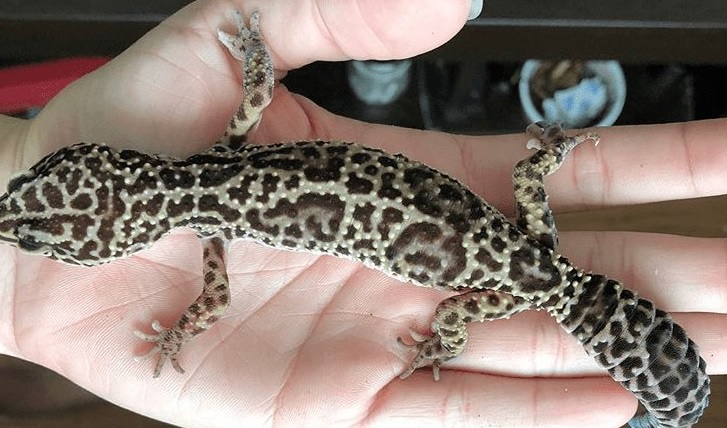For over 30 years, leopard geckos are the common reptiles captive bred in the US and are one of the most popular and amazing pets for reptile keepers of any skill level. They are super easy to care for, undemanding and come in so many beautiful morphs. If you are taking home a leopard gecko, then here is a comprehensive guide leopard gecko care – this colorful and gentle reptiles.
Contents
Habitat
Tank/Enclosure
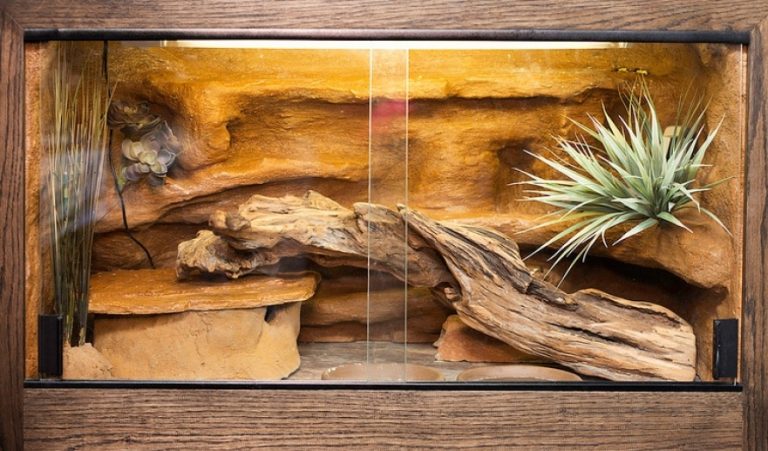
Leopard geckos are super easy to house. Some breeders commonly kept them in plastic bins, while some offer them glass enclosures. Standard glass aquariums featuring screen tops also work well.
In terms of sizes, you will have to make your gecko fee safer and prevent feeding issues caused by anxiety from spaces that are just too large. Plus, it makes it easier for them to stay warm. Although it is not an issue for all geckos, it may happen to some when placed into a large enclosure as babies. As your leo grow, you will have to “size up” their enclosure and provide them enough room to move around.
For baby geckos, a 5 – 10 gallon is enough. Meanwhile, for an adult gecko, it would be better if you get them at least a 20-gallon tank or bigger for extra room.
If you are housing multiple leopard geckos, here is one single rule that you need to follow:
Never house males together. Males are extremely territorial and they will fight for their spaces. Females, on the other hand, can live together if they are of similar size. A male and female(s) of similar size can also live together, but you probably should not do it, unless you want to constantly have little babies to raise.
For a group of geckos, you will need a larger enclosure. As a general rule, it would be safe to add 10 gallons for every 1 leopard gecko adult you have.
Substrate
Sand should not be used for substrate for leopard gecko since it can cause bowel impaction when consumed with food accidentally and may irritate their eyes. It is recommended that you get ceramic or slate tiles since they are super easy to clean, conduct heat very well, natural looking and has zero impaction risks.
The other cheap route is simply using paper towels or newspaper. They might not be as good as slate tile but they are easy to clean and works really well. You can also use repti carpet which cost more and needs to be clean and air dry since they get messy and dirty quickly.
For a moist substrate, you can go with coconut fiber. However, it is not recommended to be used throughout the whole tank since it can cause impaction as well as increasing humidity in the tank.
Also, it is important to note that you should not expose geckos to commercial sands and plant soils since it may contain pesticides or fertilizers that can harm your geckos.
Lighting
Leopard geckos originally came from the arid regions of Asia and India. They are crepuscular which means that they are active in low light, after sunset, and before sunrise. In the wild, geckos are exposed to low levels of UVB that helps them produce vitamin D naturally and use calcium in their diet.
You can try replicating this exposure inside their enclosure by using a weak 5 – 6 percent UV tube attached to the ceiling at the back of the terrarium. A leo’s skin is quite sensitive and hypersensitive morphs such as albinos shouldn’t be exposed to too much UV and are recommended to scaling it down to at least 2 percent UV tube.
Also, it is suggested that T5 bulbs are replaced every 9 months and T8 bulbs every 6 months.
Temperature
It is crucial that you have the right temperatures inside the enclosure. The temperature should be between 75 – 85 degrees Fahrenheit during the day with their basking area offering up to 90 degrees Fahrenheit.
The enclosure needs to be arranged in a way which allows a temperature gradient here there is a heated area in the higher temp range and opposite are offering cooler temperatures.
You can also provide additional heat to the enclosure by using ceramic heaters, heating pads, and suitable lights. Use reptile thermostat to monitor temperature better
Landscaping
Leopard geckos will surely appreciate an assortment of branches for climbing and basking, so you need to provide secure branches and of varying sizes. Boards covered with indoor or outdoor carpet also makes a good climbing post for your pet. You can even add a leopard gecko hammock where your pet can leisurely lounge around.
Leopard geckos spend most of their time underneath hides during the day. Thus it is crucial you provide a range of decoration which they can either get inside or under. Tubes and cork bark pieces are favorites while a cave or moss box with damp substrate helps in gecko shedding.
The enclosure should also be decorated with artificial plants for a natural look that will make your leopard geckos at ease. Desert plants are effective and provide perches for your leopard gecko. Meanwhile, trailing plants are quite good at disguising equipment or electrical wires as well as providing good cover for juvenile lizards.
Water and Humidity
It is crucial that you have a water dish always available for your gecko. Size does not matter, but you should choose a dish that is shallow enough for your pet to reach. You need to change it daily. To know if your leopard gecko is getting enough water, check on its tail and see if it’s nice and plump since that’s where they store water.
In terms of tank humidity, you need to make sure that is between 20 – 40 percent humid. Don’t keep it higher than that since your gecko might develop infections from high humidity. Use a humidifier for leopard gecko tank when you feel necessary.
Consider getting a hygrometer which allows you to measure the humidity inside and make sure that the tank has optimum humidity for your gecko’s health.
Sanitation
You need to pick up gecko waste often in order to make sure that their enclosure won’t smell. For that spot where your gecko tends to defecate, you can simply add a piece of paper towel there and change it whenever they defecate. If you are using slate tiles, then it is very easy to spot clean whenever you see fit.
Although leopard geckos are not messy creatures, in general, you will have to take everything out, including your gecko, every 4 – 5 months. This is to totally clean and disinfect the tanks and the items inside. Scrub the tank and accessories with a 33 percent bleach solution then rinse thoroughly with water to remove all traces of the bleach smell. Dry the tank and accessories completely then add a clean and dry substrate.
For daily sanitizing, warm water and anti-bacterial soap should do the job. If you suspect that your gecko is sick, have a parasite outbreak, or a gecko dies, then you will need to use Ammonia in disinfecting the tank. This is the only disinfectant which is effective in killing coccidian oocysts, giardia, and crypto.
Nutrition
Food and Diet
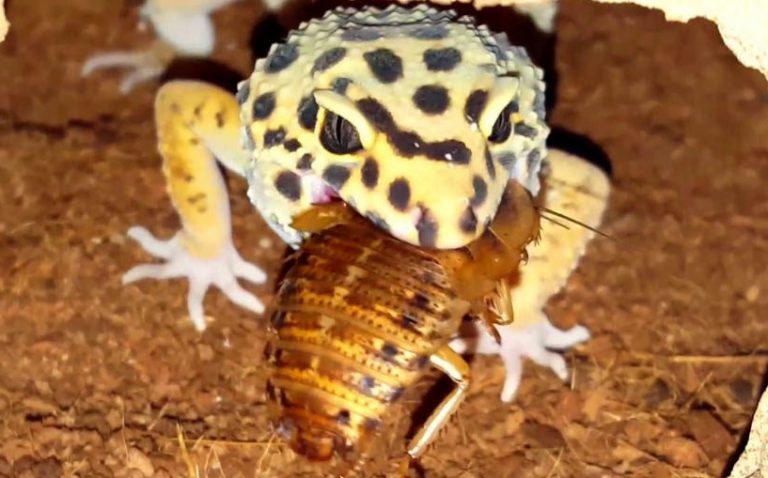
Leopard Gecko eat
Leopard geckos are insectivores, so live insects are a must. Geckos tend to eat just about any bugs which crawl in front of them, but not all insects are healthy or safe for your leopard gecko. Here are the most common insects given to leopard geckos:
Crickets: This is probably the most popular insect fed. They are easy to purchase and generally healthy. When feeding crickets to your gecko, just make sure that they are not larger than your geckos.
Mealworms: Another leopard gecko staple, mealworms are healthy and easy to get your hands on. When feeding mealworms, you need to choose the ones that are freshly molted so that they are easier to digest.
Silkworms: These are also healthy insects for your gecko and can be used to add variation to your pet’s diet. However, they do not live longer than a few weeks and are quite expensive.
Waxworms: This one needs to only be fed occasionally as a treat, at least once or twice per week. This is because waxworms are high in fat can become quite addictive to some leopard geckos.
Dubia Roaches: Another leo favorite, dubia roaches are tasty and healthy for leopard geckos. They are also quite easy to breed so most gecko owners create their own Dubia roach colony in order to save money.
Vitamins and Minerals
Unfortunately, no home diet can ever replace the variety which lizards enjoy in their natural habitat. This is you will have to supplement them with vitamins and minerals. You can do this by dusting feeder insects with special reptile mineral and vitamin supplements in powder forms before giving them to your gecko.
As for powdered supplements, you can buy multi-vitamin powder from reputable producers. You need to make sure that mix includes vitamin D3. Since leopard geckos are nocturnal or twilight creatures, they do not bask in the sun or under UVA/UVB lights. Thus, it is important that you provide them with enough vitamin D3 on their diet.
Leopard geckos need high calcium and sometimes can’t be satisfied only through dusting, particularly for breeding females and juveniles. Thus, you can just leave a tray containing pure calcium inside their enclosure. Leopard geckos with a high craving for calcium will surely find and lick it when needed. Just make sure that you use plain calcium for such purpose and not the ones mixed with vitamin D3 in order to avoid overdose.
Another great way to boot the mineral and vitamin content in your leopard gecko’s diet is to gut load your insect feeders. Gut loading only means that you will need to feed the insects with nutrient-dense and premium foods at least 24 – 48 hours before giving them to your geckos.
Foods To Avoid
Here are some bugs and insects which are toxic and unhealthy to your gecko:
Fireflies / Lighting Bugs / Any Insects That Glow: If insects can light-up or glow in the dark, then you should never feed. The chemicals which make these insects glow is extremely toxic to leopard geckos and even a single bug may contain a lethal amount of toxins. Also, there’s no known treatment since there has been no gecko that survived long enough to reach a veterinarian.
Wild Insects: Insects that you have caught inside or outside your home should never be fed to your gecko. This is because wild insects may have parasites which can infect your gecko. Also, parasites might contain trace amount of insecticides and pesticides that can be highly toxic for leopard geckos.
Growth
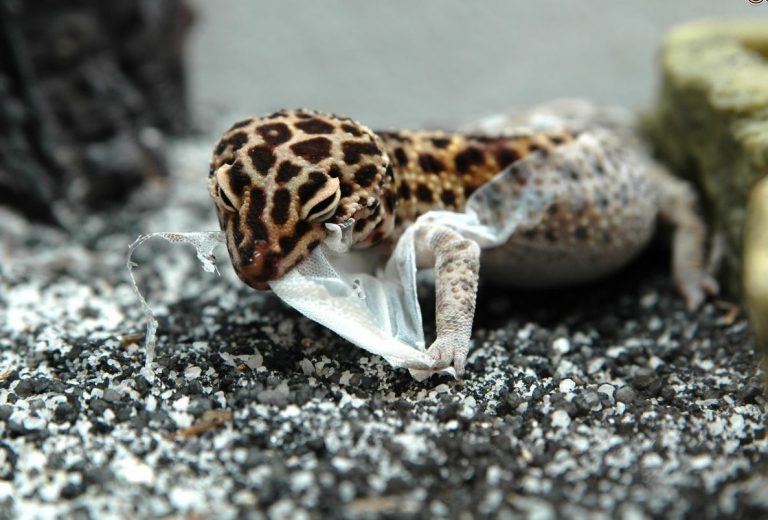
Leopard Gecko Growth
Lifespan
Leopard geckos have a longer lifespan than some reptiles. On average, a gecko can live up to 6 – 10 years, with most males living 10 – 20 years. As a matter of fact, some male geckos can still breed at 27 ½ years of age.
Leopard Gecko Hatchlings
Around 2 months on average, more precisely at least 35 – 89 days, depending on the incubation temperature, baby leopard geckos can hatch from their eggs.
Hatching happens relatively quickly and quietly, so witnessing the moment can be very rare. When born, hatchling geckos are usually 3 – 4 inches long.
Juvenile Leopard Gecko
Before their first birthday, you might see young gecko males standing on their 2 legs and “wave” a single front limb in slow circles. This is to look larger and let older males know that they recognize their dominance and won’t try to challenge them.
A male arm-waving usually stop when fully grown. Meanwhile, adult females can start waving during mating. Juvenile leopard geckos are also quite different in appearance, being boldy colored and banded. However, it lightens when they reach their adulthood.
Sexual Maturity
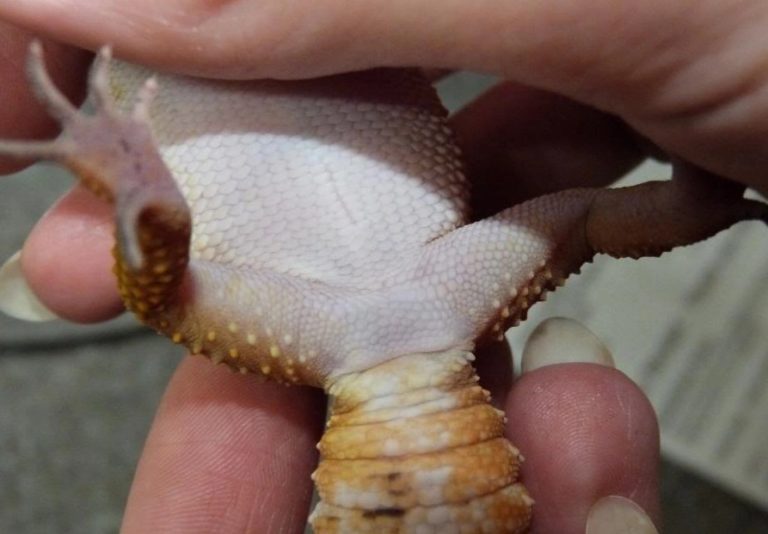
Leopard Gecko Female
Male leopard geckos usually hit sexual maturity at 6 – 8 months old. Meanwhile, female leopard geckos can hit sexual maturity and ovulate for the very first time at about 8 – 12 months old.
Size at Maturity
Most leopard geckos tend to measure 8 – 10 inches in length at adulthood, while some females approaching at least 12 inches. However, there are some males of the giant bloodlines that can reach nearly a foot.
Hibernation
Hibernation is a natural part of the yearly cycle for geckos, however, it is not necessary for pet geckos. It’s perfectly fine to keep heat throughout the winter season and they should drink, eat and be active throughout winter.
However, if you are planning on breeding your leopard gecko or want to take a break and let them hibernate, then you just need to turn off the under tank heaters, pushing them to hibernate. The ideal hibernating temperature should be 70 degrees Fahrenheit.
During the hibernation period, geckos will drink less, eat less and less active. Your gecko can remain in hibernation for at least 3 months without losing weight since their metabolism has slowed.
You can choose to feed your geckos occasionally, but only do light feeding. If your pet doesn’t want to eat during hibernation, then it is totally fine, just remove the uneaten crickets so that they won’t annoy your leo.
Normal feeding should resume in spring when hibernation period is over and they become more active.
Handling and Temperament
Generally, you don’t handle leopard geckos on a regular basis until they are more than 6 inches in length and have settled in. Once your gecko is large enough, it’s best to set it first on the floor and allow your gecko to crawl through loose fingers and hand-over-hand for at least 10 – 15 minutes daily until they are completely accustomed to your touch.
The taming process may take at least 5 – 7 days. You should never hold or grab a leopard gecko’s tail or you might risk dropping it. Usually, the tail can regenerate in less than 40 days.
Disease Prevention and Treatment
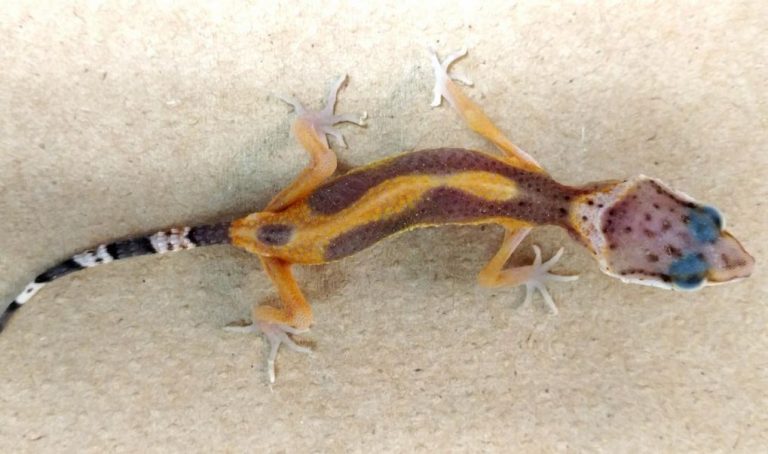
Leopard Gecko Malnutrition
If your leopard gecko does not receive the proper lighting, temperature, humidity, diet, and care that it needs, then it may develop some diseases. Here are some of the most common diseases that are found in leopard gecko.
Metabolic Bone or Vitamin Deficiency
This is the inability to absorb calcium because of improper calcium or vitamin D supplement or insufficient UVB lighting. If left untreated, metabolic bone deficiency can lead to a disorder characterized by softened bones and deformities.
Symptoms of this disease include bumps in the leg, jerky movements, twitches and spasms, swollen lower jaw and vertical columns of the back and tail. It can be treated by consulting your veterinarian and providing proper UVB lighting, diet and tank temperature.
Gastrointestinal Disease
This is characterized by runny stool, smeared or caked stool around the vent area as well as the loss of appetite caused by parasitic or bacterial infection. You can change its diet to more nutritious insects. However, if the problem persists, you should consult your veterinarian.
Respiratory Disease
If your leopard gecko’s tank is too cold or humid, then it may develop a respiratory infection. Symptoms of respiratory disease include mucus in the nose or mouth, labored breathing, gaping mouth, and puffy throat. In order to avoid this, you need to make sure that the enclosure is warm enough and remove anything which causes too much humidity such as water and plants. If symptoms worsen, you should consult your veterinarian.
Reproduction and Breeding
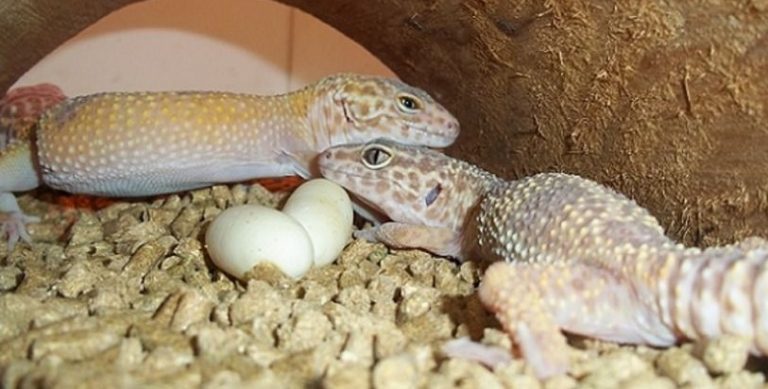
Leopard Gecko Reproduction
Mating Season
Leopard geckos follow a mating season, both in the wild and in captivity. Although this might not be always accurate, the prime mating season for leopard geckos is from February through August.
Mating Dance and Copulation
Breeding behavior is usually seen with an adult female and male leopard geckos during copulation. This unique and usually bizarre behavior is visible during the courting phases where the males will show interest and readiness to their breeding mates.
Just before mating, a male will start dancing around the female, stalking and circling the female to get close to her. You’ll see a swift wiggling, tail wagging and/or tail vibrations which may be heard.
During the pre-copulatory phase, the male will start biting the female on her neck or nape to prevent running off or holding on for mating. The female will remain calm as the male lay on top of her. She will then slightly lift her tail and the male will insert his hemipene in her cloaca.
Mating usually lasts a few minutes. After that, you will see the male licking his hemipenes to retract, but it may take at least a few hours.
Gravidity
A gravid leopard gecko will be forming the eggs during the period of 8 – 9 months.
Gravid geckos will use her fat resources in the tail to make egg yolks and the egg shells are formed with calcium.
So, during this time, you will have to provide her with high-quality diet. A gravid gecko needs to have a diet rich in calcium so you will have to gut load and dust insects with calcium supplements.
You can also offer multivitamins at least once a week. Also, provide a dedicated dish with pure calcium source and keep it inside the tank at all times. You can also feed her pinky mice 1 – 2 times a week in order to replenish her storage of nutrients.
Egg Laying
Leopard geckos will lay eggs at least 16 – 22 days after the copulation. The female will dig a hole to lay her eggs and bury them. A scattered substrate is a good sign that your gecko already laid her eggs.
You will need to remove them soon in order to prevent them from drying. Make sure that you do not change the position of the eggs when removing them. These eggs are not hard or rigid and should expand and grow. Thus, you will need to provide the right moisture and incubation.
Place the eggs in a container (can be any clear plastic container with holes for circulation) with 2 – 3 inches of medium such as peat moss, sand or vermiculite. The eggs need to be buried halfway.
The eggs will be put to an incubator for the ideal temperature. Incubation temperature will determine the sex of the eggs. If eggs are incubated at 90 degrees, then 98 percent of your hatchlings will be male. At 87 degrees, you will have an equal number of female and male geckos. At 80 degrees, 100 percent of the hatchlings will be female.
Meanwhile, temperature conditions below 74 degrees and above 95 degrees can kill the eggs. Incubation can take up to 35 – 89 days depending on the incubation temperature.
Conclusion
Leopard geckos are such wonderful creatures to own with their colorful morphs and good personality. With a lot of TLC and little maintenance, you’ll surely have no problem in keeping one of the most lovable and colorful pets imaginable!

